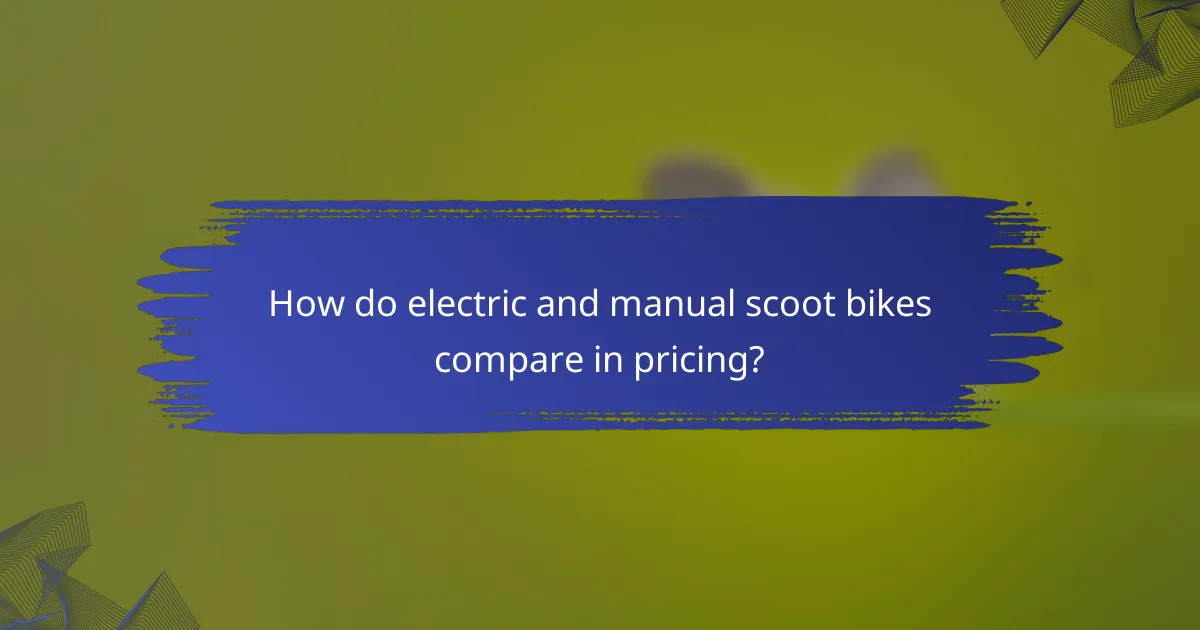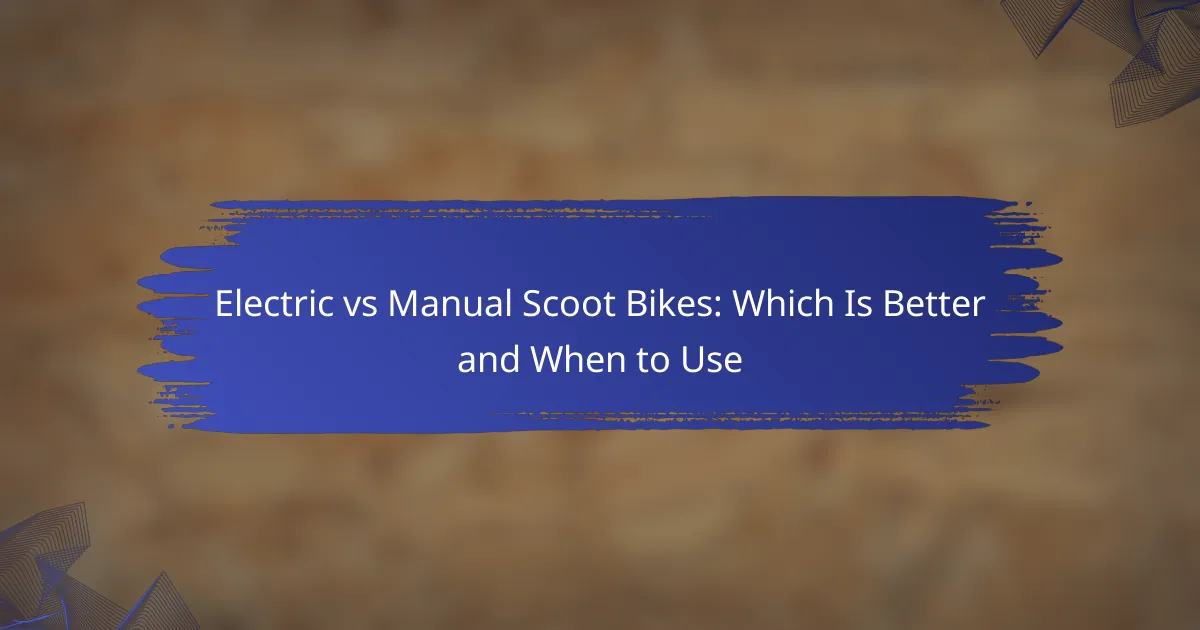When deciding between electric and manual scoot bikes, it’s essential to consider your specific needs and circumstances. Electric scoot bikes excel in speed and convenience, making them perfect for urban commuting and longer distances, while manual scoot bikes offer benefits in cost, fitness, and control. Understanding the strengths of each type can help you choose the best option for your riding experience.

What are the benefits of electric scoot bikes?
Electric scoot bikes offer several advantages over manual options, primarily in speed, ease of use, and environmental impact. They are ideal for urban commuting, providing a convenient and efficient way to navigate through traffic.
Faster travel speeds
Electric scoot bikes typically reach higher speeds compared to manual bikes, often exceeding 25 km/h (15 mph). This speed advantage allows riders to cover longer distances in a shorter time, making them suitable for daily commutes or errands.
For instance, while a manual bike may take around 30 minutes to travel 5 km, an electric bike can reduce that time significantly, often to under 15 minutes, depending on the terrain and rider’s experience.
Less physical effort required
Riding an electric scoot bike requires considerably less physical exertion than a manual bike. The electric motor assists with pedaling, making it easier to tackle hills or longer distances without excessive fatigue.
This feature is particularly beneficial for individuals who may have physical limitations or those who prefer a more relaxed ride. It allows riders to arrive at their destination without breaking a sweat, which is advantageous for commuting to work or social events.
Longer range on a single charge
Electric scoot bikes generally offer a longer range than manual bikes can cover in a single outing. Most electric models can travel between 30 to 70 km (18 to 43 miles) on a full charge, depending on the battery capacity and riding conditions.
This extended range makes electric bikes a practical choice for longer commutes or recreational rides, reducing the need for frequent recharging and allowing for more spontaneous trips.
Eco-friendly transportation option
Electric scoot bikes are a more environmentally friendly transportation choice compared to cars or scooters powered by fossil fuels. They produce zero emissions during operation, contributing to cleaner air in urban areas.
Choosing an electric bike can help reduce your carbon footprint, especially in cities where air quality is a concern. Additionally, many electric bikes are designed with recyclable materials, further enhancing their eco-friendly profile.

What are the benefits of manual scoot bikes?
Manual scoot bikes offer several advantages, particularly in terms of cost, fitness, and control. They are often more affordable and require less maintenance than electric models, making them a practical choice for many riders.
Lower purchase cost
One of the primary benefits of manual scoot bikes is their lower purchase cost compared to electric models. Prices for manual scooters can range from a few hundred to around a thousand USD, while electric versions often start at a higher price point. This makes manual bikes more accessible for budget-conscious consumers.
Additionally, since manual scoot bikes do not require batteries or complex electrical systems, the initial investment is significantly reduced. This affordability allows more people to enjoy scoot biking without financial strain.
Better for physical fitness
Manual scoot bikes provide an excellent workout, engaging various muscle groups and promoting cardiovascular health. Riding a manual scooter requires physical effort, which can help improve strength, endurance, and overall fitness levels.
For those looking to incorporate exercise into their daily routine, manual scoot bikes can be a fun and effective way to stay active. Regular use can contribute to weight management and enhance overall well-being.
Less maintenance required
Manual scoot bikes typically require less maintenance than their electric counterparts. With no batteries or electrical components to worry about, owners can focus on basic upkeep, such as tire inflation and brake adjustments.
This simplicity not only saves time but also reduces long-term costs associated with repairs and replacements. Riders can enjoy their scoot bikes without the hassle of frequent maintenance checks.
More control in various terrains
Manual scoot bikes offer greater control, especially on uneven or challenging terrains. Riders can adjust their speed and maneuverability based on the environment, making it easier to navigate hills, gravel paths, or crowded areas.
This adaptability allows for a more engaging riding experience, as users can tackle different landscapes with confidence. For those who frequently ride in urban settings or off-road conditions, a manual scoot bike can be a more versatile choice.

When should you choose an electric scoot bike?
Choose an electric scoot bike when you need a convenient, efficient mode of transportation for specific situations. These bikes are particularly beneficial for longer distances, carrying loads, and navigating busy urban environments.
For commuting longer distances
Electric scoot bikes are ideal for commuting longer distances, typically exceeding a few kilometers. They allow riders to cover more ground without excessive physical exertion, making them suitable for daily travel to work or school.
When considering an electric scoot bike for commuting, look for models with a range of at least 20-40 kilometers on a single charge. This ensures you can complete your round trip without needing to recharge during the day.
When carrying heavy loads
If you frequently transport heavy items, an electric scoot bike is a practical choice. These bikes often come equipped with stronger motors and larger cargo racks, allowing for easier handling of weighty loads.
Consider the bike’s weight capacity and cargo features when selecting a model. Many electric scoot bikes can support loads ranging from 100 to 150 kilograms, making them suitable for grocery runs or transporting equipment.
In urban environments with traffic
Electric scoot bikes excel in urban settings where traffic congestion is common. Their ability to maneuver through tight spaces and avoid gridlock makes them a time-saving option for city dwellers.
When using an electric scoot bike in traffic, prioritize models with good braking systems and visibility features. Always adhere to local traffic regulations, and consider wearing a helmet for safety.

When should you choose a manual scoot bike?
Choosing a manual scoot bike is ideal for those who prioritize physical activity, short-distance travel, and navigating hilly terrains. These bikes offer a hands-on riding experience that can enhance fitness and provide better control in certain environments.
For short trips
Manual scoot bikes are perfect for short trips, typically under 5 kilometers. They allow for quick and efficient travel without the need for charging or maintenance associated with electric models.
For instance, if you’re commuting to a nearby café or running errands in your neighborhood, a manual scoot bike can be a convenient choice. You can easily park it and avoid the hassle of finding charging stations.
When exercising is a priority
If fitness is your main goal, a manual scoot bike is an excellent option. Riding manually engages your muscles, providing a workout that can improve cardiovascular health and build strength.
Consider using a manual bike for daily exercise routines or when you want to incorporate physical activity into your commute. This option allows you to control the intensity of your workout based on your pace and effort.
In areas with steep hills
Manual scoot bikes excel in hilly areas where electric models may struggle with battery life. Climbing steep inclines requires physical effort, making manual bikes more reliable in such terrains.
When navigating hills, you can adjust your pedaling to maintain speed and control, which can be more effective than relying on an electric motor. This makes manual scoot bikes a smart choice for regions with varied elevation.

How do electric and manual scoot bikes compare in pricing?
Electric scoot bikes generally have a higher upfront cost compared to manual scoot bikes, but they can offer savings in the long run through reduced maintenance and fuel costs. Understanding the pricing differences is essential for making an informed decision based on your budget and usage needs.
Average cost of electric scoot bikes
The average cost of electric scoot bikes typically ranges from around $400 to $2,000, depending on features, battery capacity, and brand. Higher-end models with advanced technology and longer ranges will be on the pricier side.
When considering an electric scoot bike, look for models that offer a good balance of price, performance, and warranty. Some brands may provide financing options, which can help manage the initial investment.
Average cost of manual scoot bikes
Manual scoot bikes are generally more affordable, with prices ranging from approximately $100 to $600. The lower cost reflects the absence of electrical components and batteries, making them a budget-friendly option for casual riders.
While manual scoot bikes are less expensive upfront, they may require more physical effort and can be less convenient for longer distances. Consider your riding habits when choosing between manual and electric options.
Long-term cost considerations
When evaluating long-term costs, electric scoot bikes can save money on fuel and maintenance, as they typically require less frequent servicing than manual bikes. However, battery replacement can be a significant expense, often costing several hundred dollars after a few years.
Manual scoot bikes may have lower initial costs, but they can incur higher maintenance costs over time, especially if used frequently. Consider factors like repair needs, replacement parts, and your typical usage to determine the best option for your financial situation.








